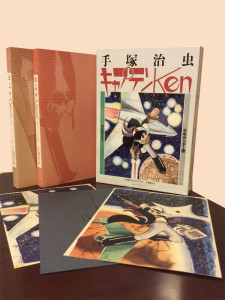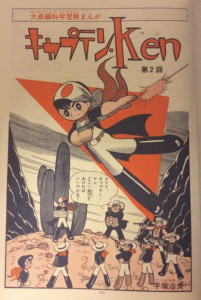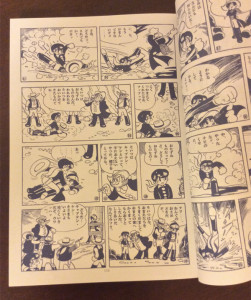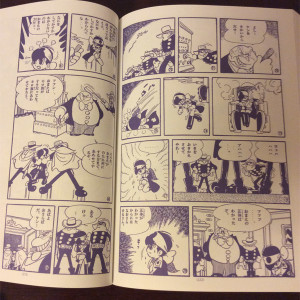Captain Ken – Shonen Sunday Box Set
One of the most highly-prized items in my personal Osamu Tezuka collection is the replica Captain Ken Shonen Sunday Limited Edition BOX set.
What is it?
Between 2011-13, Shogakukan Creative released archive-quality reprints of several of Tezuka’s shonen (boys) adventure series under the banner of it’s “Shonen Sunday Limited Edition BOX” Series. Captain Ken (1960-61) was actually the second set to be released (in February 2012) after Zero Men (1959-60), was first released in June 2011. Shogakukan Creative subsequently released White Pilot (1961-62) in March and Brave Dan (1962) in April 2013, before completing the series with Dr. Thrill (1959) in February 2013.
Meticulously reprinting each series as it originally appeared in Weekly Shonen Sunday – complete with the full-colour and duo-tone pages, in-house adverts, and original serial chapter breaks – the series basically covers Osamu Tezuka’s output in the periodical from its inception in 1959 through 1962, lacking only the 2-part short-story The Graffiti Encylopedia (1959) [らくがき事典]. The rest of Tezuka’s major Weekly Shonen Sunday output – basically Wonder 3 (1965-66), Vampires (1966-67) and Dororo (1967-68) – were given the archive treatment in the “Tezuka Osamu Treasure Box” series from Kokusho Kankōkai.
| Captain Ken Shonen Sunday Box Set | |
| Language: | Japanese |
| Publication Date: | 2012/02/28 |
| ISBN-13: ISBN-10: |
9784-778031992 4778031997 |
| No. of pages: (Format) | 576 pages (B5) |
| Cover Price: | ¥8,400 |
The set itself is beautiful, coming in a heavy-duty cardstock box, with a flip-up cover rather than just a slipcase. The manga itself is printed on a heavy, presumably acid-free stock and is divided into two volumes. Although the set contains the original serialized chapters, the volumes break in the same place as the standard Osamu Tezuka Complete Manga Works editions (MT-025 and MT-026). Although the two volumes lack real cover artwork, I think the watermark-style creates a very elegant and classy presentation. Besides, packaged with with the box are 3 beautiful full-colour reporductions of Tezuka’s painted cover artwork for Captain Ken (1960-61) – nicely protected by a dark blue folder. So it’s not as if we’re really missing out.
Why I Love It!
Mainly I love it because I’m fascinated by the evolution of Osamu Tezuka’s storytelling and artwork. Before it was printed in English through DMP’s successful Kickstarter campaign in 2014, very little was known outside of Japan about Tezuka’s work, Captain Ken (1960-61). It has never (to-date) been printed in any other languages than Japanese (and Chinese). So, while doing research online about the series, I ran across numerous vague references to the changes Osamu Tezuka had made to the series when it was reprinted in the Osamu Tezuka Complete Manga Works editions (MT-025 and MT-026) in 1978. Partially the references were “Google translate” vague, but also because most of the online sources simply quoted the same couple of lines about Tezuka “changing the ending to make it clearer that Hoshino Mamoru is Ken’s father”. Also, as is often the case, the official Tezuka Productions website, wasn’t particularly helpful as it doesn’t even mention it.
So, while there’s probably only a (very small) handful of (English-speaking) people who are actually interested in what the changes look like, I’m one of them. Not having been a kid growing up in 1960’s Japan, much of the world of Osamu Tezuka’s weekly/monthly serialized work has been like a giant mystery just waiting to be uncovered. Why do the chapters and publications dates seem to be out of sync? Why are some story chapters significantly longer than others? What are these “special editions” and/or “supplemental inserts” (sometimes also referred to as “appendix”)? Why do some of the B&W artwork on some pages (i.e the duo-tone ones) look different than the rest of the chapter?
While still very enjoyable, the “standard” versions of his manga – those almost always printed nowadays – don’t really tell the story. The serial chapter breaks have all been removed and the artwork smoothed over (and rightfully so) to ensure a pleasant reading experience chapter by chapter and volume by volume. But they don’t give you a sense of what it was like to get a new chapter of Tezuka’s latest adventure, hot off the press.
Flipping through the pages of this edition answer some of those questions. For some strange reason, I find it incredibly interesting to compare and contrast the two versions of Tezuka’s tale. It’s like finding out a huge secret that directly following the initial meeting/fist-fight between Mamoru and Ken, there was a sequence where-in Ken is captured by Mayor Devlin’s henchmen and tied to a cactus – something which was completely cut-out of the final version (check out Vol. 1 page 24 of your DMP edition if you don’t believe me). Of course, that pales in comparison to the sequence where Mayor Devlin hooks Ken up to a mind-reading device and finds out his big secret (no spoilers!). The fact that the standard version still includes a scene with the pontificating Mayor Devlin still standing next to the (now irrelevant) machine is almost too much to take. It’s like a secret inside-joke staring you right in the face (on Vol. 1 page 201) – hilarious only to those who are in on it.
Where I got it
I got my copy online at the Amazon.co.jp site, although it retails for about ¥8,500 I was lucky enough to get it used for less than half of that. For me it was still a bit pricey, which is also partly why I treasure it so much. I’ve also found it several times on the Mandarake website. Oh, and of course I got my copy of Captain Ken in English from DMP’s Kickstarter campaign, but you can get yours from their Akadot.com retail store.







Leave a Reply